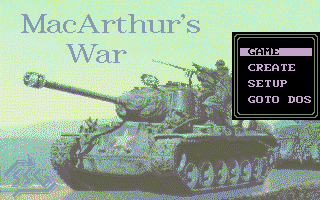Retro Replay Review
Gameplay
MacArthur’s War: Battles for Korea delivers a classic turn-based wargame experience that places you squarely in command of UN forces or the Chinese general staff. Each turn unfolds on a detailed hex-based map, challenging you to balance offense, defense and supply lines. The interplay of terrain—from the 38th Parallel’s rolling hills to the frozen Chosin Reservoir—adds tactical depth, forcing you to consider every elevation and chokepoints when planning your moves.
(HEY YOU!! We hope you enjoy! We try not to run ads. So basically, this is a very expensive hobby running this site. Please consider joining us for updates, forums, and more. Network w/ us to make some cash or friends while retro gaming, and you can win some free retro games for posting. Okay, carry on 👍)
The game’s eight scenarios, including “Across the 38th,” Taejon and the Imjin River, recreate pivotal engagements of the Korean War. Each scenario is self-contained, offering a distinct strategic puzzle: can you redeploy reinforcements fast enough to hold the Naktong Bulge, or will your forces be overwhelmed at Unsan? For hardcore strategists, the option to escalate into a broader Asian or global showdown adds an extra layer of strategic gravitas.
Interface-wise, MacArthur’s War keeps things streamlined. Units are represented by simple but clear icons, and contextual menus allow you to access orders—move, attack, fortify—quickly. Supply counters and victory point markers are readily visible, reducing fiddly bookkeeping. If anything, the minimal UI underscores the game’s focus on chess-like planning rather than flashy animations.
One of the game’s strongest points is its AI. The computer opponent adapts to your tactics, launching counterattacks when you overextend and reinforcing weak fronts with surprising speed. While not infallible, the AI strikes a decent balance of challenge and fairness, making single-player sessions both tense and rewarding.
Graphics
Visually, MacArthur’s War embraces 2D simplicity. The map is rendered in muted tones—olive drab for plains, white for snow-covered mountains—creating an atmosphere that feels suitably austere for a Cold War conflict. This palette may appear dated compared to modern 3D titles, but it ensures clarity: you always know which hex you’re targeting and where friendly or enemy units are located.
Unit icons are straightforward: infantry, armor, artillery and air support are each given distinct symbols that remain legible at a glance. When zooming in, unit counters display strength values and morale markers, so you never have to guess your forces’ readiness. In the heat of battle, this level of clarity helps maintain strategic momentum.
Animations are minimal—movement is indicated by a brief path highlight, and combat resolves through numerical reports rather than flashy explosions. While this might disappoint players seeking visual spectacle, it complements the game’s simulation roots. The austere presentation reinforces that this is a study in military logistics and leadership rather than a blockbuster action piece.
Occasionally, terrain transitions can feel abrupt, and there’s no dynamic weather system. However, the lack of distracting visual effects helps the strategic elements shine. In a genre where readability often trumps realism, MacArthur’s War strikes a commendable balance.
Story
As a historical simulation, MacArthur’s War doesn’t feature a cinematic narrative but instead weaves its story through scenario briefings and historical context. Before each engagement, you receive a concise overview of objectives, order of battle and political stakes—reminding you that every decision could shift the Cold War’s trajectory.
The role of Douglas MacArthur is more conceptual than character-driven; you won’t see dialogue trees or cutscenes, but you will feel his presence in the weight of strategic choices. Conversely, when assuming command of Chinese forces, you’re reminded of Mao’s broader political aims. This dual perspective deepens immersion, urging you to think like both an American ally and a Chinese strategist.
Scenario backgrounds are well-researched, citing troop strengths, historical timelines and key challenges. This educational layer doesn’t read like dry encyclopedia text; it’s woven into game mechanics, influencing reinforcements and victory conditions. As you advance or retreat, you’re re-living campaigns that shaped the early Cold War.
Overall Experience
For enthusiasts of historical wargames, MacArthur’s War offers a compelling, no-frills campaign that rewards careful planning and adaptive tactics. Replayability is high: testing different strategies in each of the eight scenarios or flipping allegiances keeps every playthrough fresh. The option to escalate into a broader conflict adds even more depth for those who crave “what if” situations.
Newcomers to the genre may find the interface austere, but tutorials and tooltips ease you into turn-based mechanics. There’s a learning curve, particularly around supply management and coordination of multi-branch forces, yet mastering these systems yields a satisfying sense of command achievement.
Although it lacks modern visual bells and whistles, the game’s tight focus on strategic substance makes it a standout for dedicated wargamers. Whether you’re aiming to replicate history or rewrite it, MacArthur’s War: Battles for Korea rewards patience, foresight and a keen understanding of Cold War dynamics.
In the end, this title is best suited for players who appreciate deep, thoughtful simulations over fast-paced action. If you’re looking to immerse yourself in one of the 20th century’s most volatile conflicts—and to test your mettle as a commander on either side—MacArthur’s War offers an engaging, informative journey through the Korean War’s pivotal battles.
 Retro Replay Retro Replay gaming reviews, news, emulation, geek stuff and more!
Retro Replay Retro Replay gaming reviews, news, emulation, geek stuff and more!









Reviews
There are no reviews yet.